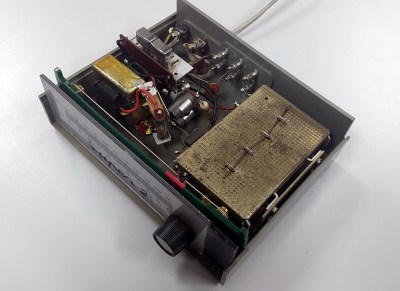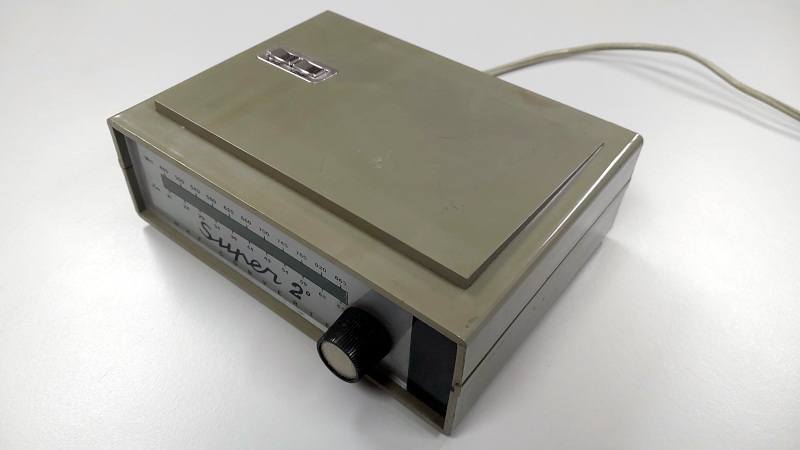As Hackaday writers we don’t always know what our colleagues are working on until publication time, so we all look forward to seeing what other writers come up with. This week it was [Al Williams] with “Things Your TV No Longer Needs“, a range of gadgets from the analogue TV era, now consigned to the history books. On the bench here is a device that might have joined them, so in taking a look at it now it’s by way of an addendum to Al’s piece.
When VHF Was Not Enough
 In a Dutch second-had store while on my hacker camp travels this summer, I noticed a small grey box. It was mine for the princely sum of five euros, because while I’d never seen one before I was able to guess exactly what it was. The “Super 2” weighing down my backpack was a UHF converter, a set-top box from before set-top boxes, and dating from the moment around five or six decades ago when that country expanded its TV broadcast network to include the UHF bands. If your TV was VHF it couldn’t receive the new channels, and this box was the answer to connecting your UHF antenna to that old TV.
In a Dutch second-had store while on my hacker camp travels this summer, I noticed a small grey box. It was mine for the princely sum of five euros, because while I’d never seen one before I was able to guess exactly what it was. The “Super 2” weighing down my backpack was a UHF converter, a set-top box from before set-top boxes, and dating from the moment around five or six decades ago when that country expanded its TV broadcast network to include the UHF bands. If your TV was VHF it couldn’t receive the new channels, and this box was the answer to connecting your UHF antenna to that old TV.
It’s a relatively small plastic case about the size of a chunky paperback book, on the front of which is a tuning knob and scale in channels and MHz, on the top of which are a couple of buttons for VHF and UHF, and on the back are a set of balanced connectors for antennas and TV set. It’s mains powered, so there’s a mains lead with an older version of the ubiquitous European mains plug. Surprisingly it comes open with a couple of large coin screws on the underside, so it’s time to take a look inside.
Inside: A Familiar Sight
![RF-front-end TV tuner front end block diagram. Chetvorno, [CC0].](https://i0.wp.com/hackaday.com/wp-content/uploads/2016/07/rf-front-end.jpg?w=466&h=262&ssl=1)
At first sight it’s fairly simple: a conventional mains DC power supply with no regulator and a metal tuner can. The scale mechanism is a string-and-gears affair, something quite common back in the day but a rare sight today. Unclipping the lid of the tuner can reveals its secret, this is the front end of a UHF TV tuner modified slightly to produce an output on a VHF broadcast channel. We’ve covered UHF TV tuners in the past, but if you’ve never encountered them here’s how they worked. Inside the can is a series of cavity tuned circuits containing two transistors. One of them is wired as an RF amplifier that works on the signal from the antenna, and the other is an oscillator. By mixing the amplified antenna signal with the oscillator output it’s possible to filter out an intermediate frequency, which is their difference. This was always 36 MHz, chosen because it lies just below the VHF broadcast band, and since this tuner needs to feed an unmodified VHF television, its output frequency will be a bit higher. We’re guessing that it’s been modified for a 41.25 MHz output, corresponding to the European VHF channel 1.
So in front of me I have a European thing that your TV no longer needs, and it’s one that probably didn’t have a very long market life. It’s a snapshot of a moment in consumer electronics history, when the number of channels could be counted on far less than the fingers of a hand. With analogue TV now long switched off it’s not even got a use any more except as a curio, so it joins the pile of museum-pieces alongside the 8-track player. Meanwhile if you’d like to see how an American city handled the UHF transition, we’ve been back to 1950s Portland, too.
















Of course, UK TVs would not have benefited from that device as the UHF transmissions were in 625 lines, and had a totally different standard to the VHF 405 line pictures.
Incidentally, I used to have an earlier example of a similar convertor that enabled VHF Band 3 signals to be seen on a Band 1 only set (a Bush TV22) in the 1960s.
It’s just a simple RF frequency converter; it doesn’t care about the modulation method.
In the US, UHF tuners were used to receive analog cellular phone calls. A UHF TV could receive them all by itself (one frequency at a time with careful tuning), but a better way was to bypass the tuner’s bandpass filter and feed the tuner’s output into a scanner capable of receiving 50-70 MHz. Then you could scan the entire cellular band.
“It’s just a simple RF frequency converter; it doesn’t care about the modulation method.”
Right, but commenter IanS didn’t imply saying otherwise with his comment, I think.
What I think he meant was that the converter had little use in his place, because each band (UHF vs VHF) had used a different TV standard, anyway.
It’s a bit like with the French, for example.
They had an 819 line standard that was monochrome (“b/w TV”) and was incompatible to the 625 line standard.
Consequently, 819 line programmes had been aired by a few TV channels only.
https://en.wikipedia.org/wiki/819_line
“What I think he meant was that the converter had little use in his place, because each band (UHF vs VHF) had used a different TV standard, anyway.”
Exactly, thank you.
Just curious if you know, what did European countries do with the VHF TV frequencies after they stopped using them?
The VHF-low – amateurs have gotten two slivers of spectrum, maybe 0,5MHz in total around 50 and around 70MHz (though the one around 70 is spectrum that once was in used by the analog radio systems from the cops, fire dept and such i think)
On the VHF-H, afaik there is DAB+ radio broadcasting, probably also some extra space for mobile radio stuff.
For the Netherlands you can find the complete list of allocations here, at paragraph 10: https://wetten.overheid.nl/BWBR0035791/2024-02-01#Bijlage
We had a service back in the early 80’s called “SuperTV” in my area. It was an over-the-air paid service. It broadcast on channel 54. The signal was scrambled and decoded with a simple one-button set-top box set to output on channel 3. The service included a cute little “cornered” log-periodic antenna for mounting and a monthly “TV guide” publication for the programming.
The service only broadcast in the evening, starting with kids movies, then mainstream and R movies, and several days a week finishing up the broadcast day deep into the night with adult programming. The first time I saw Star Wars and Time Bandits was on SuperTV. I’m not sure if there was normal daytime programming – I believe there was.
It eventually fell out of favor due to the market penetration of cable TV. Channel 54 became a normally-programmed TV station and eventually joined the UPN network.
I recall this experience right alongside the top-loading VCR with the WIRED remote.
Ah yes, blue boob TV – when viewed without the box.
Explains the popularity of Avatar years later.
Ours was a box brand named ” ON tv”. The box had one knob and it was marked off to the left an ON to the right. I also believe it was US channel 54.
Channel 52 in the Los Angeles area…and those boxes were easy to hack.
“box had one knob” yes I think I also saw that film :-)
I remember spending way too much time on the scrambled channels vainly trying to catch a glimpse of a boob.
Tuis comment just made me laugh in a quiet public place. Cannot relate at all.
I’ve got (somewhere in the shed) yet another TV device that’s no longer used – it called itself a color corrector, and it output on channel 3 or 4, like a VCR, except it had a knob for some kind of color correction that I never used. What I did with it back in the day was to plug some composite security cameras into a switcher, and then the box, and then I could view them using the RF input of a TV instead of needing a composite input. I could even receive it wirelessly using a portable TV in the other room. Not bad, back before anyone was watching videos over wifi or on their phone, able to pause anytime they wanted. Plus, no real latency!
I miss the once ubiquitous dead analog TV tuners, yours for the taking. Really nice for RF projects.
It’s certainly not hard to generate an analog signal from any time and country from a live digital feed.
I’d expect any self respecting TV collector to have all the formats coming out of distribution boxes.
Early 60’s we like most had VHF only and 60 miles away all 3 networks. One of those was available locally UHF but not seen by most in town. I remember a service man putting in a converter strip with just passives on it into the13th slot on our RCA turret tuner which always needed cleaning once a year or so. It never worked very well then we got cable that long ago. TV could have been tuned like a radio with sound and clear picture only in 5 places on the dial for 2-6 and switching bands 7-13, 2 more spots but tuning would be perfect each time. Some last gen portables did do this. Instead the most hideous switching of fiddly signals and coils was devised inside of an electrostatic air cleaner (dust) just so it’d be click easy.
That is the Bulgarian version. https://www.kn34pc.com/sch/sch_device/ptp_216.html
We had something similar for when TV expanded from VHF band 1 into VHF band 3
I heard about these being sold in the US in like the 1950s. Per Wikipedia, 35% of TVs made in 1952 had UHF tuners; it dropped to 9% by 1958. Partly because the earliest UHF tuners weren’t very good; partly because of shenanigans (like, a company owned TV stations — which were on VHF — and made TVs, so no UHF tuner for you.)
But VHF was full in some markets (some never got a single VHF station), and many new stations were getting UHF assignments. So in 1964 the FCC passed a rule REQUIRING new TVs to have UHF tuners.
I remember when tv’s had fine-tuning knobs.
what blew me away as an 80s kid was when the later sets did away with them, ngl
you really buried the lede; that tuned-waveguide VHF bit – i almost went to my grave not learning that!
Anyone remember the “clicker” – ultrasonic pinging remotes? I just found a two function zenith remote while cleaning the garage. When I lost it in the couch, I could duplicate the sounds by tossing change on a metal tv tray.